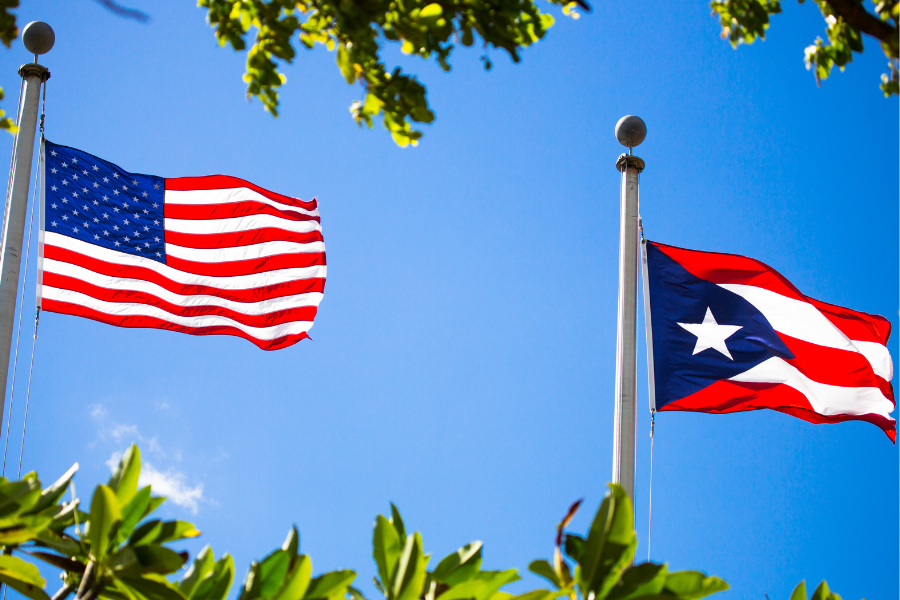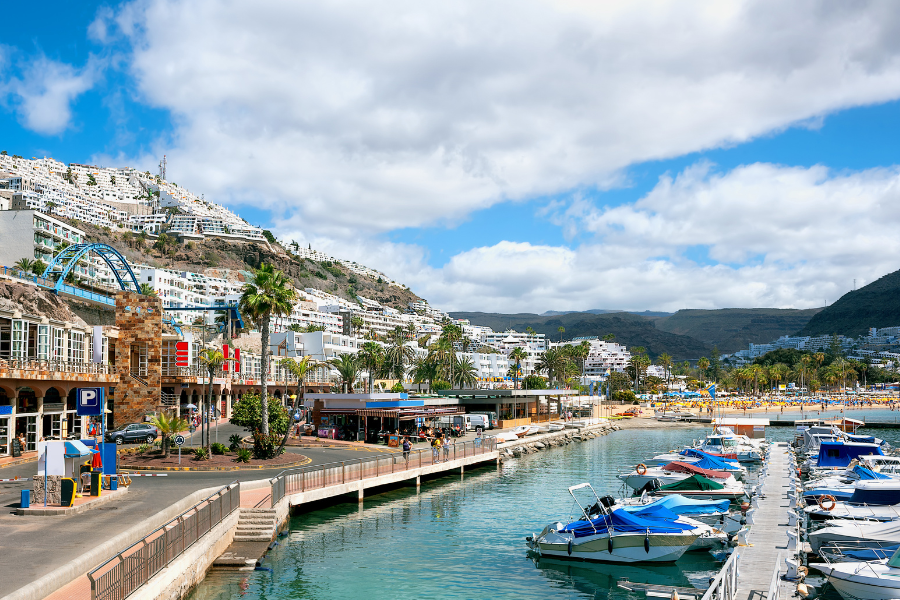
September 18, 2022. A history of Puerto Rico’s relationship with the US.
Should Puerto Rico become the 51st American state?
A group of mostly Democratic lawmakers thinks so, having pushed the Biden administration in recent weeks to hold a binding vote on Puerto Rico's statehood, with hopes of welcoming this commonwealth into the union.
It’s not just some lawmakers who’d like to add another star to the American flag: A majority of Americans support Puerto Rico's statehood as well—and have since the 1960s.
That said, this proposal might not go far as it doesn’t have the support of the entire Congress, particularly members of the Republican party, who have been historically opposed to the idea. A series of non-binding votes in Puerto Rico shows that although there is support to become a state, the island’s citizens are less inclined to do so.
Stacker compiled a list of key events that help explain Puerto Rico's relationship with the United States using news and government reports as well as historic records. Read on to learn more about why the concept of Puerto Rico statehood is so complicated.
1898: Puerto Rico comes under US military control.
On Christopher Columbus' second voyage to the Antilles in 1493, he claimed the island that would eventually be known as Puerto Rico for Spain.
The people there started an independence movement in the late 1800s, after centuries under Spanish rule, which led to Spain’s acquiescence to allow the colony to self-govern in 1897. Unluckily for the local population, Spain and the U.S. went to war in 1898 before this government could really get off the ground. When Spain lost the war, it ceded the territory to the U.S.
1900: Foraker Act creates a civilian government.
The U.S. ended its military occupation of Puerto Rico in 1898. On April 2, 1900, President McKinley signed the Foraker Act, also known as the Organic Act of 1900, which created a civilian government.
Puerto Rico was thereafter led by an appointed governor and executive council, as well as a popularly elected house of delegates and resident commissioner who sat as a non-voting member in the U.S. House of Representatives. This structure wasn’t particularly popular in Puerto Rico because the executive council also received unchecked veto power, which created an unbalanced system.
1906: Theodore Roosevelt becomes the first sitting US president to visit Puerto Rico.
President Theodore Roosevelt broke tradition and became the first sitting president to travel abroad when he visited Panama and Puerto Rico in November 1906. In Puerto Rico—or Porto Rico as America referred to it then—he visited many towns and cities across the island.
The president found the people of Puerto Rico to be loyal to the United States, and to repay them for that loyalty he recommended they be granted full American citizenship by the U.S. Congress. The request wasn't granted for more than a decade.
March 1917: Jones Act passes, Puerto Rico Residents gain US citizenship.
President Woodrow Wilson signed the Jones-Shafroth Act—also known simply as the Jones Act—in 1917, granting U.S. citizenship to Puerto Rico Citizens. The law also altered the island’s present governmental structure, separating its three branches of government into separate legislative, judicial, and executive branches. Citizens now had their own bill of rights and they could elect members of Puerto Rico’s new Senate and House of Representatives.
Citizenship also meant that Puerto Rico Residents could freely move to the U.S., which about 42,000 of them did in the 1920s.
May 1917: The Selective Service Act allows Puerto Rico Citizens to be drafted into WWI
Shortly after the passage of the Jones-Shafroth Act, Congress passed the Selective Service Act in May 1917 in an effort to build up the U.S. military. The U.S. had entered World War I a month earlier, and its all-volunteer military wasn’t getting the numbers it needed to fight Germany.
The Selective Service Act required men ages 21-30—later expanded to ages 18 to 45—to register with the government and potentially be drafted to serve in the war.
As Puerto Rico Residents were newly minted U.S. citizens, they were also subject to this law and made up about 20,000 of the 2.8 million men drafted for World War I. Ultimately, some 65,000 Puerto Ricans served before the war’s end in 1918.
1930s: Doctors in Puerto Rico push women into sterilizations as the only means of contraception.
The Puerto Rico Government in 1937 passed laws that legalized contraception and allowed a eugenics board to authorize sterilization procedures on women, claiming the legislation would control overpopulation and curb poverty and unemployment.
The U.S. government got on board with the latter effort and sent advocates to the island to encourage women to be sterilized surgically, claiming it was an effective method of birth control.
Estimates suggest 7% of Puerto Rico Women were sterilized, mostly postpartum, by 1948—a number that jumped to 16% by 1954. As of 1956, “la operación” (the operation) was so prevalent, 1 out of 3 women were unable to give birth to children.
The sterilization law was repealed in 1960.
1932: The name of the island returns to Puerto Rico (from the Americanized Porto Rico)
Although Puerto Ricans themselves used the Spanish spelling of the island’s name, English speakers had used the anglicized “Porto Rico” since 1899 when journalist Robert T. Hill defied his editors and used it in a National Geographic article. The spelling stuck after the U.S. won the Spanish-American War when “Porto Rico” was used in the Treaty of Paris.
On Dec. 18, 1931, Félix Córdova Dávila, the island’s Resident Commissioner in the U.S. House of Representatives, introduced a resolution to change the name back to Puerto Rico, as was the will of the people. After some argument in Congress about the expense of changing the name on things like stamps and money, lawmakers voted in favor of reverting the island’s name back to the original in May 1932.
1935: Puerto Rico Reconstruction Administration created.
President Franklin Roosevelt created the Puerto Rico Reconstruction Administration as part of the Emergency Relief Appropriation Act of 1935. This extended Roosevelt’s New Deal programs to the island, which was also suffering from the Great Depression and two major hurricanes that swept through the island in 1928 and 1932. The PRRA funded projects to employ thousands and spur agricultural development, public works, and electrification of the island.
Funding for the PRRA decreased after 1941, and the program fully ended in 1955.
1940s: Operation Bootstrap aims to diversify Puerto Rico’s economy
Gov. Luis Muñoz Marín developed Operation Bootstrap in the mid-1940s to modernize Puerto Rico’s economy and lessen its dependence on agriculture. The project focused on industrialization and exports, providing tax exemptions to the U.S. and other foreign companies that invested in Puerto Rico.
The program was wildly successful, growing the island’s manufacturing base in number of factories, people employed, and economic output, growing its valuation from $93 million in 1949 to $621 million in 1967.
1941: Puerto Rico’s island of Vieques is assigned as a US Naval Training Range
The U.S. Navy commandeered two-thirds of this 55-square-mile island off the coast of Puerto Rico and used it for military testing and exercises, firing more than 300,000 munitions on the land and water. These included depleted uranium shells, napalm, Agent Orange, and other toxic chemicals.
Only after decades of protests against the environmental contamination caused by chemical storage and testing facilities, operations at the base were closed in 2003. Although the area was turned into a federal wildlife refuge, it’s also a Superfund site that is still undergoing environmental clean-up. The waters of Vieques are now home to the highest concentration of bioluminescent plankton in the world.
1947: Elective Governors Act allows Puerto Ricans to elect their own governor.
President Truman’s appointment of Jesús T. Piñero as the first native to serve as governor of Puerto Rico laid the groundwork for the Elective Governors Act.
Piñero chose Antonio Fernós-Isern as his replacement for Resident Commissioner to the U.S. Congress, and Fernós-Isern worked to get the Elective Governors Act—also known as the Crawford Project—passed. This law allowed Puerto Ricans to elect their own governor, a move that inherently gave citizens control over the island’s executive branch, as the governor was responsible for appointing those positions.
1948: Law 53, aka the Gag Law, is enacted.
As early as 1914, nationalists in Puerto Rico sought independence from the U.S. However, not everyone was inclined to leave U.S. control, including Gov. Piñero, who signed La Ley de La Mordaza—the Gag Law—into law.
This outlawed patriotic activities like owning or displaying a Puerto Rico flag, singing patriotic songs, or talking publicly about independence, any of which was grounds for imprisonment. Before it was repealed in 1957, thousands of islanders were tracked by secret police or spent time in jail.
1948: Puerto Rico gets its own Olympic team.
Even though Puerto Rico is a commonwealth of the U.S., it competes as its own country at the Olympics.
This started at the 1948 Summer Olympics in London, which were the first games held after World War II. In seeking more country participation in the games, the International Olympic Committee expanded its definition of a country and included Puerto Rico as an independent entity. To this day, Puerto Rico participates independently from the U.S. in the summer and winter Olympics.
1950: Puerto Rico Federal Relations Act passes.
The Puerto Rico Federal Relations Act, also known as Public Law 600, enabled the organization of a local government on the island, including the development of an independent constitution. While Puerto Rico's Citizens were charged with writing and ratifying this document, the U.S. did stipulate that the local government must be a republic and that the constitution must include a bill of rights.
After President Truman signed the act into U.S. law in July 1950, Puerto Rico’s constitutional convention finished its document in February 1952. It passed in a referendum that spring and was fully adopted on July 25, 1952.
1952: Puerto Rico becomes a US commonwealth.
With the implementation of its own constitution, Puerto Rico opted to be known as a “commonwealth” of the U.S. This didn’t mean Puerto Rico had become a full state of the union; in fact, it remained a U.S. territory.
Puerto Rico was different from other U.S. territories by virtue of the fact that it still managed its own governmental affairs despite having a special relationship with the U.S . Puerto Ricans maintained their statuses as U.S. citizens, but were unable to vote in U.S. federal elections.
1956: Puerto Rico is home to storage and testing of Agent Orange.
Developed by the U.S. military working in conjunction with the University of Chicago, Agent Orange was a herbicide mixture that could be used during war to kill off vegetation and destroy soldiers’ hiding places. Its development also created dioxin, a toxic contaminant that can cause a number of health issues including cancer and damage to the immune system.
For several periods between 1956 right up to when it was used during the Vietnam War, the U.S. Department of Defense stored and conducted Agent Orange tests around Mayaguez on the western coast of Puerto Rico. No official studies have been conducted to review the effects of this chemical on the island’s population and health.
1967: Puerto Rico holds first status referendum.
Puerto Ricans took to the polls in 1967 for the first of many referendums to determine whether the island should remain a commonwealth, officially become a state, or seek independence. Although fewer than two-thirds of voters participated in this referendum, 60% voted to remain a commonwealth while 38.9% wanted to seek statehood. Fewer than 1% of voters opted for independence.
1978: UN Special Committee on Decolonization designates Puerto Rico a colony of the US.
The United Nations recognized Puerto Rico as a commonwealth starting in 1953, citing its ability to have its own constitution and self-elected government. However, as many African nations gained independence from their colonial leaders, the U.N. started taking another look at Puerto Rico’s situation.
The U.N. declared in 1978 that the island did meet the definition of a colony and has been advocating for its independence ever since.
1990s to 2020: Puerto Rico holds 5 non-binding referendums for statehood.
By the 1990s, Puerto Rico was once again seeking entry to the union to become the 51st state and held a series of referendums to gauge the people’s will.
Puerto Ricans in 1993 narrowly opted to remain a commonwealth. In 1998, statehood gained more votes, but both options lost out to “none of the above.” Referendums in 2012 and 2017 showed great support for statehood, but the U.S. Congress did not change the commonwealth’s status. 2020 saw a narrow win for statehood, but the referendum was non-binding and once again, Congress did not act on it.
2017: Puerto Rico files for the largest municipal bankruptcy in US history.
After accruing a $70 billion public debt load due to decades of mismanagement, corruption, and failed U.S. development policies—in addition to $50 billion in public pension liabilities—Puerto Rico declared bankruptcy, the first-ever U.S. state or territory to do so.
A federal judge in January 2022 approved a restructuring plan that reduced Puerto Rico's debt by 80% and saved it $50 billion on debt payments. This deal was the largest of its kind in U.S. history.
2017-2022: Puerto Rico hit by a series of devastating earthquakes and hurricanes.
In September 2017, Puerto Rico experienced a double whammy of devastation when hurricanes Irma and Maria battered the island. Huge swaths of critical infrastructure across the island were destroyed, causing an estimated 3,000 deaths and knocking out power for 1.5 million people for 11 months.
Although Puerto Rico’s government looked to the U.S. for support, the island’s status as a colony and its bankruptcy filing were used as reasoning by the Trump administration to delay sufficient financial aid for rebuilding.
The island has not been spared by natural disasters since: Beginning in late December 2019 and lasting into 2022, an earthquake swarm struck the southwestern part of Puerto Rico. Tropical Storm Isaias in 2020 caused flooding that killed one person and caused $59.5 million in damage.
Wrote by Stacker Reporter. Edited by Sault Tribe Guardian Staff.
The Sault Tribe Guardian supports Puerto Rico and the Taina People. The Taina People

